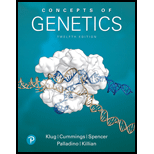
Concepts of Genetics Plus Mastering Genetics with Pearson eText -- Access Card Package (12th Edition) (What's New in Genetics)
12th Edition
ISBN: 9780134811390
Author: William S. Klug, Michael R. Cummings, Charlotte A. Spencer, Michael A. Palladino, Darrell Killian
Publisher: PEARSON
expand_more
expand_more
format_list_bulleted
Textbook Question
Chapter 18, Problem 3CS
DM1 is characterized by a phenomenon known as genetic anticipation (see Chapter 4) where the age of onset tends to decrease and the severity of the symptoms tend to increase from one generation to the next due to expansion of the trinucleotide repeats in the DMPK gene. What are the implications of a diagnosis of DM1 in this patient with respect to his 4-year-old son, and 2-year-old daughter?
Expert Solution & Answer
Want to see the full answer?
Check out a sample textbook solution
Students have asked these similar questions
Plating 50 microliters of a sample diluted by a factor of 10-6 produced 91 colonies. What was the originalcell density (CFU/ml) in the sample?
Every tutor here has got this wrong, don't copy off them.
Suppose that the population from question #1 (data is in table below) is experiencing inbreeding depression (F=.25) (and no longer experiencing natural selection). Calculate the new expected genotype frequencies (f) in this population
after one round of inbreeding. Please round to 3 decimal places.
Genotype
Adh Adh
Number of Flies
595
Adh Adh
310
Adhs Adhs
95
Total
1000
fladh Adh-
flAdn Adh
fAdhs Adh
Chapter 18 Solutions
Concepts of Genetics Plus Mastering Genetics with Pearson eText -- Access Card Package (12th Edition) (What's New in Genetics)
Ch. 18 - Some mutations in the tra gene of Drosophila cause...Ch. 18 - Some scientists use the analogy that the...Ch. 18 - Consider the example that actin mRNA localization...Ch. 18 - What is alternative splicing, where does it occur,...Ch. 18 - What role might the expanded tri- and...Ch. 18 - DM1 is characterized by a phenomenon known as...Ch. 18 - HOW DO WE KNOW? In this chapter, we focused on how...Ch. 18 - CONCEPT QUESTION Review the Chapter Concepts list...Ch. 18 - List three types of alternative splicing patterns...Ch. 18 - Consider the CT/CGRP example of alternative...
Ch. 18 - Explain how the use of alternative promoters and...Ch. 18 - Explain how a tissue-specific RNA-binding protein...Ch. 18 - The regulation of mRNA decay relies heavily upon...Ch. 18 - Nonsense-mediated decay is an mRNA surveillance...Ch. 18 - AU-rich elements (AREs) are cis-elements in mRNAs...Ch. 18 - What are processing bodies (P bodies), and what...Ch. 18 - In 1998, future Nobel laureates Andrew Fire and...Ch. 18 - Present an overview of RNA interference (RNAi)....Ch. 18 - RNAi may be directed by small interfering RNAs...Ch. 18 - Prob. 14PDQCh. 18 - In principle, RNAi may be used to fight viral...Ch. 18 - Prob. 16PDQCh. 18 - Prob. 17PDQCh. 18 - Prob. 18PDQCh. 18 - Prob. 19PDQCh. 18 - How is it possible that a given mRNA in a cell is...Ch. 18 - Prob. 21PDQCh. 18 - Prob. 22PDQCh. 18 - Prob. 23PDQCh. 18 - Prob. 24ESPCh. 18 - Prob. 25ESPCh. 18 - Mutations in the low-density lipoprotein receptor...Ch. 18 - RNA helicases are a class of proteins that bind...Ch. 18 - While miRNA response elements (MREs) may be...Ch. 18 - RNAi is currently being tested as a therapeutic...Ch. 18 - The localization and translational control of...Ch. 18 - Explain how the expression of a single gene can be...
Knowledge Booster
Learn more about
Need a deep-dive on the concept behind this application? Look no further. Learn more about this topic, biology and related others by exploring similar questions and additional content below.Similar questions
- Which of the following best describes why it is difficult to develop antiviral drugs? Explain why. A. antiviral drugs are very difficult to develop andhave no side effects B. viruses are difficult to target because they usethe host cell’s enzymes and ribosomes tometabolize and replicate C. viruses are too small to be targeted by drugs D. viral infections usually clear up on their ownwith no problemsarrow_forwardThis question has 3 parts (A, B, & C), and is under the subject of Nutrition. Thank you!arrow_forwardThey got this question wrong the 2 previous times I uploaded it here, please make sure it's correvct this time.arrow_forward
- This question has multiple parts (A, B & C), and under the subject of Nutrition. Thank you!arrow_forwardCalculate the CFU/ml of a urine sample if 138 E. coli colonies were counted on a Nutrient Agar Plate when0.5 mls were plated on the NA plate from a 10-9 dilution tube. You must highlight and express your answerin scientific notatioarrow_forwardDon't copy off the other answer if there is anyarrow_forward
arrow_back_ios
SEE MORE QUESTIONS
arrow_forward_ios
Recommended textbooks for you
 Human Heredity: Principles and Issues (MindTap Co...BiologyISBN:9781305251052Author:Michael CummingsPublisher:Cengage Learning
Human Heredity: Principles and Issues (MindTap Co...BiologyISBN:9781305251052Author:Michael CummingsPublisher:Cengage Learning Biology (MindTap Course List)BiologyISBN:9781337392938Author:Eldra Solomon, Charles Martin, Diana W. Martin, Linda R. BergPublisher:Cengage Learning
Biology (MindTap Course List)BiologyISBN:9781337392938Author:Eldra Solomon, Charles Martin, Diana W. Martin, Linda R. BergPublisher:Cengage Learning Human Biology (MindTap Course List)BiologyISBN:9781305112100Author:Cecie Starr, Beverly McMillanPublisher:Cengage Learning
Human Biology (MindTap Course List)BiologyISBN:9781305112100Author:Cecie Starr, Beverly McMillanPublisher:Cengage Learning Anatomy & PhysiologyBiologyISBN:9781938168130Author:Kelly A. Young, James A. Wise, Peter DeSaix, Dean H. Kruse, Brandon Poe, Eddie Johnson, Jody E. Johnson, Oksana Korol, J. Gordon Betts, Mark WomblePublisher:OpenStax College
Anatomy & PhysiologyBiologyISBN:9781938168130Author:Kelly A. Young, James A. Wise, Peter DeSaix, Dean H. Kruse, Brandon Poe, Eddie Johnson, Jody E. Johnson, Oksana Korol, J. Gordon Betts, Mark WomblePublisher:OpenStax College

Human Heredity: Principles and Issues (MindTap Co...
Biology
ISBN:9781305251052
Author:Michael Cummings
Publisher:Cengage Learning


Biology (MindTap Course List)
Biology
ISBN:9781337392938
Author:Eldra Solomon, Charles Martin, Diana W. Martin, Linda R. Berg
Publisher:Cengage Learning


Human Biology (MindTap Course List)
Biology
ISBN:9781305112100
Author:Cecie Starr, Beverly McMillan
Publisher:Cengage Learning

Anatomy & Physiology
Biology
ISBN:9781938168130
Author:Kelly A. Young, James A. Wise, Peter DeSaix, Dean H. Kruse, Brandon Poe, Eddie Johnson, Jody E. Johnson, Oksana Korol, J. Gordon Betts, Mark Womble
Publisher:OpenStax College
QCE Biology: Introduction to Gene Expression; Author: Atomi;https://www.youtube.com/watch?v=a7hydUtCIJk;License: Standard YouTube License, CC-BY